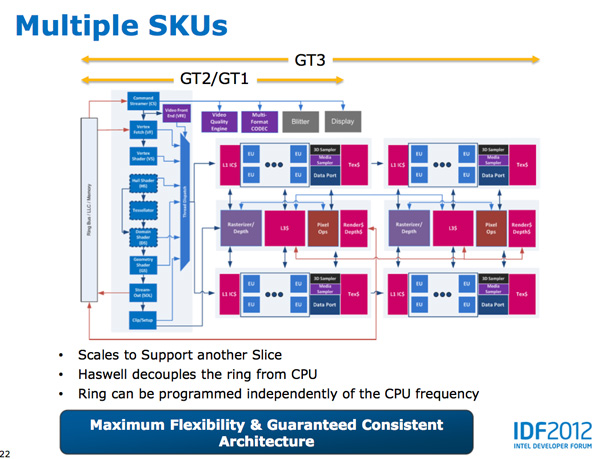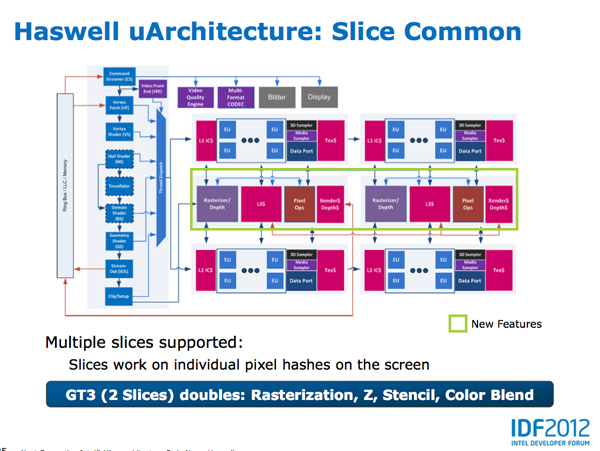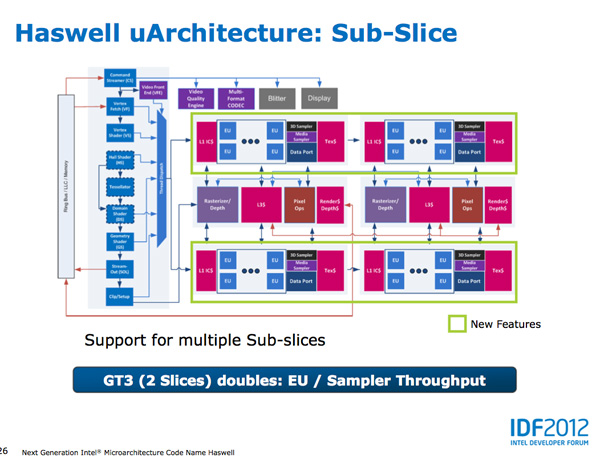Intel's Haswell Architecture Analyzed: Building a New PC and a New Intel
by Anand Lal Shimpi on October 5, 2012 2:45 AM ESTHaswell's GPU
Although Intel provided a good amount of detail on the CPU enhancements to Haswell, the graphics discussion at IDF was fairly limited. That being said, there's still some to talk about here.
Haswell builds on the same fundamental GPU architecture we saw in Ivy Bridge. We won't see a dramatic redesign/re-plumbing of the graphics hardware until Broadwell in 2014 (that one is going to be a big one).
Haswell's GPU will be available in three physical configurations: GT1, GT2 and GT3. Although Intel mentioned that the Haswell GT3 config would have twice the shader count of Haswell GT2, it was careful not to disclose the total number of EUs in any of the versions. Based on the information we have at this point, GT3 should be a 40 EU configuration while GT2 should feature 20 EUs. Intel will also be including up to one redundant EU to deal with the case where there's a defect in an EU in the array. This isn't an uncommon practice, but it does indicate just how much of the die will be dedicated to graphics in Haswell. The larger of an area the GPU covers, the greater the likelihood that you'll see unrecoverable defects in the GPU. Redundancy at the EU level is one way of mitigating that problem.
Haswell's processor graphics extends API support to DirectX 11.1, OpenCL 1.2 and OpenGL 4.0.
At the front of the graphics pipeline is a new resource streamer. The RS offloads some driver work that the CPU would normally handle and moves it to GPU hardware instead. Both AMD and NVIDIA have significant command processors so this doesn't appear to be an Intel advantage although the devil is in the (unshared) details. The point from Intel's perspective is that any amount of processing it can shift away from general purpose CPU hardware and onto the GPU can save power (CPU cores go to sleep while the RS/CS do their job).
Beyond the resource streamer, most of the fixed function graphics hardware sees a doubling of performance in Haswell.
At the shader core level, Intel separates the GPU design into two sections: slice common and sub-slice. Slice common includes the rasterizer, pixel back end and GPU L3 cache. The sub-slice includes all of the EUs, instruction caches and EUs.
In Haswell GT1 and GT2 there's a single slice common, while GT3 sees a doubling of slice common. GT3 similarly has two sub-slices, although once again Intel isn't talking specifics about EU counts or clock speeds between GT1/2/3.
The final bit of detail Intel gave out about Haswell's GPU is the texture sampler sees up to a 4x improvement in throughput over Ivy Bridge in some modes.
Now to the things that Intel didn't let loose at IDF. Although originally an option for Ivy Bridge (but higher ups at Intel killed plans for it) was a GT3 part with some form of embedded DRAM. Rumor has it that Apple was the only customer who really demanded it at the time, and Intel wasn't willing to build a SKU just for Apple.
Haswell will do what Ivy Bridge didn't. You'll see a version of Haswell with up to 128MB of embedded DRAM, with a lot of bandwidth available between it and the core. Both the CPU and GPU will be able to access this embedded DRAM, although there are obvious implications for graphics.
Overall performance gains should be about 2x for GT3 (presumably with eDRAM) over HD 4000 in a high TDP part. In Ultrabooks those gains will be limited to around 30% max given the strict power limits.
As for why Intel isn't talking about embedded DRAM on Haswell, your guess is as good as mine. The likely release timeframe for Haswell is close to June 2013, there's still tons of time between now and then. It looks like Intel still has a desire to remain quiet on some fronts.














245 Comments
View All Comments
stop-a - Saturday, October 6, 2012 - link
100% agree on the well engineered part especially on the antenna gate when Steve God was saying "you're holding wrong", plus the recently ingeniously designed sapphire glass lens camera when Tim Schmok was saying "stay away from bright light source". Boy, Apple products must be engineered straight from the heaven; they are just too perfect for a mere earthling to use.Paer0 - Saturday, October 6, 2012 - link
@stop-a. Since you are a 100% Apple hater, let me ask you this what computer do you use? And what OS do you use on it? I hope it doesn't crash several times a day. I use a MacBook Pro 2012 and I don't see anything come close.Urizane - Saturday, October 6, 2012 - link
You really shouldn't use the 'crash several times a day' piece anymore. I'm annoyed every time I see this. My Windows 7 machine has an uptime of 20 days and counting. Most of the time, it waits for me to connect to it via SplashTop or FTP, or it's recording TV shows, but when I play games, I stress it bigtime. Seriously, stop with the Windows constantly crashes crap. It's just plain false now.P.S. - 20 days ago, I brought it to another house, thus the interruption in uptime.
StevoLincolnite - Saturday, October 6, 2012 - link
I have a Dual socket 2011 motherboard with dual Core i7 3930K's both chips clocked to 4.6ghz, 32gb of ram, Triple Radeon 7970 3gb cards powering 3x 27" Dell U2711 monitors in Eyefinity.Kay go. Lets see if your Mac can keep up or a Mac workstation at the same price. (Hint: Not going to happen.)
Besides, Mac's look ugly, I prefer the whole she-bang of a side window with a nice water cooling loop and having the whole thing light up, not some dull silver box.
Plus, my system is completely stable. Never had a crash yet with Windows 7 and... I have access to the last couple of decades worth of software and games, not to mention emulation of other platforms.
I can also pretty much find software and hardware easily and it will "just work" I never have to ask the question of: Will it work on a Mac?
lmcd - Saturday, October 6, 2012 - link
I don't think you're in their target audience, for some reason. They're the best preconfigured system out there, especially once you ignore price.Magik_Breezy - Sunday, October 14, 2012 - link
You'd hope a manufacturer can "configure" a system for an extra $1,400Hardware: $400
I'm Apple: $1,400
Total: $1,800
With PCs manufacturers almost always loose money selling motherboards
vt1hun - Tuesday, October 9, 2012 - link
Two Core i7s working on a dual 2011 socket motherboard? You need QPI links for that which only certain Xeons have. Sounds like your system will just NOT work !FunBunny2 - Tuesday, October 9, 2012 - link
If Steve hadn't done what Apple does best (according to Steve) "steal" BSD unix, would you still be crowing?Magik_Breezy - Sunday, October 14, 2012 - link
His operating system doesn't crash 7 times a day because he doesn't run OS X, I'll rephrase that, because he isn't a retardHisDivineOrder - Sunday, October 7, 2012 - link
Let's not forget the obscenely high failure rates due of Macbook Pro's because they are huge, metallic, and yet refuse to have vents ruin the smooth awesomeness of their aesthetic.Whoops, for many it won't last more than two years, if that. Hell, if you're lucky, your battery will give out before your laptop cooks. Regardless, look up what Apple suggests and you'll get:
Buy another one. Yours is old. ;)